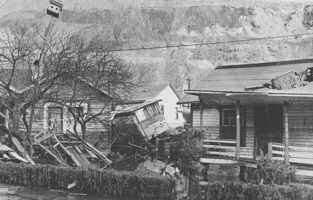Start date February 26, 1972 | ||
 | ||
Similar 1972 Black Hills flood, Val di Stava dam collapse, Monongah mining disaster, 1985 Election day floods, Upper Big Branch Mine disa | ||
The Buffalo Creek flood was a disaster that occurred on February 26, 1972, when the Pittston Coal Company's coal slurry impoundment dam #3, located on a hillside in Logan County, West Virginia, burst, four days after having been declared 'satisfactory' by a federal mine inspector.
Contents

The resulting flood unleashed approximately 132,000,000 US gallons (500,000 m3) of black waste water, cresting over 30 ft high, upon the residents of 16 coal towns along Buffalo Creek Hollow. Out of a population of 5,000 people, 125 were killed, 1,121 were injured, and over 4,000 were left homeless. 507 houses were destroyed, in addition to forty-four mobile homes and 30 businesses. The disaster destroyed or damaged homes in Saunders, Pardee, Lorado, Craneco, Lundale, Stowe, Crites, Latrobe, Robinette, Amherstdale, Becco, Fanco, Braeholm, Accoville, Crown and Kistler. In its legal filings, Pittston Coal referred to the accident as "an Act of God."

Dam #3, constructed of coarse mining refuse dumped into the Middle Fork of Buffalo Creek starting in 1968, failed first, following heavy rains. The water from Dam #3 then overwhelmed Dams #2 and #1. Dam #3 had been built on top of coal slurry sediment that had collected behind dams # 1 and #2, instead of on solid bedrock. Dam #3 was approximately 260 feet above the town of Saunders when it failed.

Investigation
Two commissions investigated the disaster. The first, the Governor's Ad Hoc Commission of Inquiry, appointed by Governor Arch A. Moore, Jr., was made up entirely of either members sympathetic to the coal industry or government officials whose departments might have been complicit in the genesis of the flood. After then-president of the United Mine Workers Arnold Miller and others were rebuffed by Gov. Moore regarding their request that a coal miner be added to the Governor's commission, a separate Citizen's Commission assembled to provide an independent review of the disaster. The Governor's Commission of Inquiry report [1] called for new legislation and further inquiry by the local prosecutor. The Citizen's Commission report [2] concluded that the Buffalo Creek-Pittston Coal Company was guilty of murdering at least 124 men, women and children. Additionally, the chair of the Citizen's Commission and Deputy Director of the West Virginia Department of Natural Resources Norman Williams called for the legislature to outlaw coal strip mining throughout the state. Williams testified before the legislature that strip mining could not exist as a profit-making industry unless it is allowed by the state to pass on the costs of environmental damage to the private landowner or the public.

The state of West Virginia also sued the Buffalo Creek-Pittston Coal Company for $100 million in disaster and relief damages, but a smaller settlement was reached for just $1 million with Governor Arch A. Moore, Jr. three days before he left office in 1977. The lawyers for the plaintiffs, Arnold & Porter of Washington, D.C., donated a portion of their legal fees for the construction of a new community center. West Virginia has yet to build the center, though the center was promised by Governor Moore in May 1972.

Gerald M. Stern, an attorney with Arnold & Porter, wrote a book entitled The Buffalo Creek Disaster about representing the victims of the flood. The book includes descriptions of his experiences dealing with the political and legal environment of West Virginia, where the influence of large coal mining corporations is intensely significant to the local culture and communities. Sociologist Kai T. Erikson, son of distinguished psychologist and sociologist Erik Erikson, was called as an expert witness and published a study on the effects of the disaster entitled Everything In Its Path: Destruction of Community in the Buffalo Creek Flood (1978). Erikson's book later won the 1977 Sorokin Award, granted by the American Sociological Association for an "outstanding contribution to the progress of sociology."
Simpson-Housley and De Man (1989) found that, 17 years later, the residents of Buffalo Creek scored higher on a measure of trait anxiety in comparison to the residents of Kopperston, a nearby coal town that did not experience the flood.
Results
Dennis Prince and some 625 survivors of the flood sued the Pittston Coal Company, seeking $64 million in damages ($292 million in 2011 dollars). They settled in June 1974 for $13.5 million, or approximately $13,000 for each individual after legal costs ($62.4 thousand each in 2014 dollars). A second suit was filed by 348 child survivors, who sought $225 million; they settled for $4.8 million in June 1974.
Miscellaneous
Kerry Albright became known as the "miracle baby" of the disaster. Running from the leading edge of the water, his mother threw him just above the flood level moments before she drowned. He survived with few ill effects, and was raised by his father. His survival gave hope and inspiration to other survivors.
In the NCIS episode "Corporal Punishment", Dr. Mallard references the Buffalo Creek Disaster when discussing PTSD in a soldier returning from the Iraq War.
On their 2004 release, the band American Minor includes a song titled "Buffalo Creek" that was written about the Buffalo Creek disaster.
